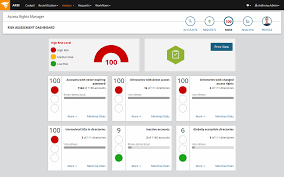The Importance of Active Directory Risk Management
Active Directory is a crucial component of many organisations’ IT infrastructures, serving as the central hub for managing user accounts, permissions, and access to resources. With its pivotal role in network security and operations, it is essential for businesses to implement effective risk management strategies to safeguard their Active Directory environment.
Identifying Risks
One of the first steps in active directory risk management is identifying potential risks and vulnerabilities within the system. Common risks include unauthorised access to sensitive data, insider threats, misconfigurations, and outdated software. Conducting regular security assessments and audits can help pinpoint these risks before they escalate into serious security incidents.
Implementing Security Controls
Once risks are identified, it is crucial to implement appropriate security controls to mitigate them. This may involve enforcing strong password policies, limiting user privileges based on the principle of least privilege, implementing multi-factor authentication, and regularly monitoring and reviewing access rights. By establishing robust security controls, organisations can reduce the likelihood of security breaches and data leaks.
Monitoring and Detection
Continuous monitoring of Active Directory activity is essential for detecting suspicious behaviour or unauthorised access in real-time. Implementing automated monitoring tools can help organisations track changes made to user accounts, group memberships, or permissions within the directory. Timely detection of anomalies allows for swift response and containment of potential security threats.
Incident Response Planning
In the event of a security incident or breach involving Active Directory, having a well-defined incident response plan is critical. Organisations should outline clear procedures for containing the incident, investigating its root cause, remediating vulnerabilities, and restoring normal operations. Regularly testing and updating the incident response plan ensures that teams are prepared to handle security incidents effectively.
Compliance and Auditing
Compliance with industry regulations such as GDPR, HIPAA, or PCI DSS requires maintaining a secure Active Directory environment. Regular audits help ensure that security controls are functioning as intended and that any deviations from compliance standards are promptly addressed. Auditing also provides valuable insights into user behaviour patterns and helps identify areas for improvement in risk management practices.
Conclusion
In today’s digital landscape where cyber threats are constantly evolving, proactive active directory risk management is essential for protecting sensitive data and maintaining operational continuity. By identifying risks, implementing robust security controls, monitoring activity closely, planning for incidents, and ensuring compliance with regulations through regular auditing practices, organisations can strengthen their defences against potential security threats in their Active Directory environment.
Five Essential Tips for Managing Active Directory Risks Effectively
- Regularly review and update user permissions to ensure least privilege access.
- Implement multi-factor authentication to enhance security for user accounts.
- Monitor Active Directory logs for any suspicious activities or unauthorized access.
- Regularly backup Active Directory data to prevent loss in case of system failures or cyber attacks.
- Train employees on best practices for password management and security awareness.
Regularly review and update user permissions to ensure least privilege access.
Regularly reviewing and updating user permissions is a crucial aspect of active directory risk management. By adhering to the principle of least privilege access, organisations can minimise the potential impact of security breaches and insider threats. Ensuring that users only have access to the resources necessary for their roles helps prevent unauthorised activities and reduces the risk of data exposure. Continuous monitoring and adjustment of user permissions align with best practices in maintaining a secure Active Directory environment, promoting data integrity and enhancing overall network security.
Implement multi-factor authentication to enhance security for user accounts.
Implementing multi-factor authentication is a highly effective tip for enhancing security in Active Directory risk management. By requiring users to provide additional verification beyond just a password, such as a code sent to their mobile device or biometric data, organisations can significantly reduce the risk of unauthorised access to user accounts. Multi-factor authentication adds an extra layer of protection, making it more challenging for malicious actors to compromise user credentials and ensuring a higher level of security for sensitive data stored within the Active Directory environment.
Monitor Active Directory logs for any suspicious activities or unauthorized access.
Monitoring Active Directory logs for any suspicious activities or unauthorized access is a critical tip in active directory risk management. By regularly reviewing log data, organisations can proactively identify potential security threats, such as unusual login attempts, changes to user permissions, or suspicious account behaviour. Detecting these anomalies early on allows for prompt investigation and mitigation of security risks, helping to safeguard the integrity of the Active Directory environment and prevent potential data breaches.
Regularly backup Active Directory data to prevent loss in case of system failures or cyber attacks.
Regularly backing up Active Directory data is a crucial aspect of effective risk management. By creating and maintaining backups of critical information, organisations can mitigate the impact of system failures or cyber attacks that may compromise their Active Directory environment. In the event of data loss or corruption, having up-to-date backups ensures that businesses can quickly restore their directory services and resume normal operations, minimising downtime and potential disruptions to business continuity.
Train employees on best practices for password management and security awareness.
Training employees on best practices for password management and security awareness is a crucial aspect of active directory risk management. By educating staff on creating strong, unique passwords, avoiding phishing scams, and recognising suspicious activities, organisations can significantly reduce the risk of unauthorised access to their Active Directory. Empowering employees with the knowledge and skills to protect their accounts not only enhances the overall security posture of the organisation but also fosters a culture of cybersecurity awareness and responsibility among staff members.

